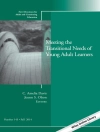Benefiting from the support and involvement of two major international research networks, this collection features the latest research findings in TVET. Members of INAP, the International Network on Innovative Apprenticeship, and VETNET, the Vocational Education and Training Network, have contributed key research findings to this detailed survey of the field. Featuring the inclusion of the internationally recognized memorandum released in April 2012 by the INAP Architecture Apprenticeship Commission, the volume covers a wealth of issues relating to technical and vocational education and training, including exemplar architectures such as successful school-to-work transitions, competence assessment and development models, and governance, including the role of stakeholders. The book provides many opportunities to explore in depth the scholarly debate on TVET, as well as to learn from positive international experiences. It aims to inform the practice of TVET professionals as much as the decision making of administrators.
Содержание
1. From School into Apprenticeship: Pathways for a Successful Transition.- 1.1 Relationship between Potential Recruits from VET and HE — Case Studies from Germany, England and Switzerland, Ute Hippach-Schneider, Tanja Weigel.- 1.2 Exploring Intermediate Vocational Education and Training for 16-19 Year-olds in Germany and England, Jeremy Higham, H.-Hugo Kremer, David Yeomans.- 1.3 Apprenticeship, Pathways and Career Guidance: A Cautionary Tale.- Richard Sweet.- 1.4 No Choice – No Guidance? The rising demand for career guidance in EU neighboring countries and its potential implications for apprenticeships, Helmut Zelloth.- 1.5 How can Governance, Private Sector and Work Based Learning promote Labour Market Relevant Training in Developing and Transition Countries?, Manfred Wallenborn.- 1.6 A Renaissance for Apprenticeship Learning? — And its Implications for Transition Countries, Sören Nielsen.- 1.7 Work-based Learning in China, Joanna Burchert, Ludger Deitmer, Xu Han.- 2. Competence Measurement and Development .- 2.1 Occupational Identity in Australian Traineeships: An initial Exploration, Erica Smith.- 2.2 Competency-Based Training in Australia: What happened and where might we “capably” go? Lewis Hughes, Len Cairns.- 2.3 Measuring Occupational Competences: Concept, Method and Findings of the COMET project, Felix Rauner, Lars Heinemann, Ursel Hauschildt.- 2.4 Occupational Identity and Motivation of Apprentices in a System of Integrated Dual VET, Ursel Hauschildt, Lars Heinemann.- 2.5 Innovative Models of more Interactive Cooperation of VET Schools and Enterprise in China, Zhiqun Zhao, Zishi Luo, Donglian Gu.- 2.6 Developing Complex Performance through Learning Trajectories and re-creating Mediating Artefacts.- Michael Eraut.- 2.7 Conceptual Change Research in TVET, Waldemar Bauer.- 2.8 Experiential Learning Assessment and Competence Development for a Second Career: The case of alternating training pprogrammes for professional promotion, Philippe Astier, Lucie Petit.- 3. Towards an Open TVET Architecture: Why European and National Qualification Frameworks do not suffice.- 3.1 Differences in the Organisation of Apprenticeship in Europe: Findings of a Comparative Evaluation Study, Felix Rauner, Wolfgang Wittig.- 3.2 Implementing the EQF: English as distinct from Continental Bricklaying Qualifications, Michaela Brockmann, Linda Clarke, Christopher Winch.- 3.3 Trends, Issues and Challenges for EU VET Policies beyond 2010, Pascaline Descy, Guy Tchibozo, Jasper van Loo.- 3.4 ‘Evidence’ about ‘Outcome Orientation’ – Austrian experience with European policies, Lorenz Lassnigg.- 3.5 Successful in Reforming the TVET System and Shaping the Society: The Example of the Mubarak Kohl Initiative, Edda Grunwald, Bernhard Becker.- 3.6 Accelerating Artisan Training: A Response to the South African Skills Challenge, Salim Akoojee.- 3.7 The Role of Social Partners and the Status of Apprenticeship in Turkey, Özlem Ünlühisarcıklı, Arjen Vos.












